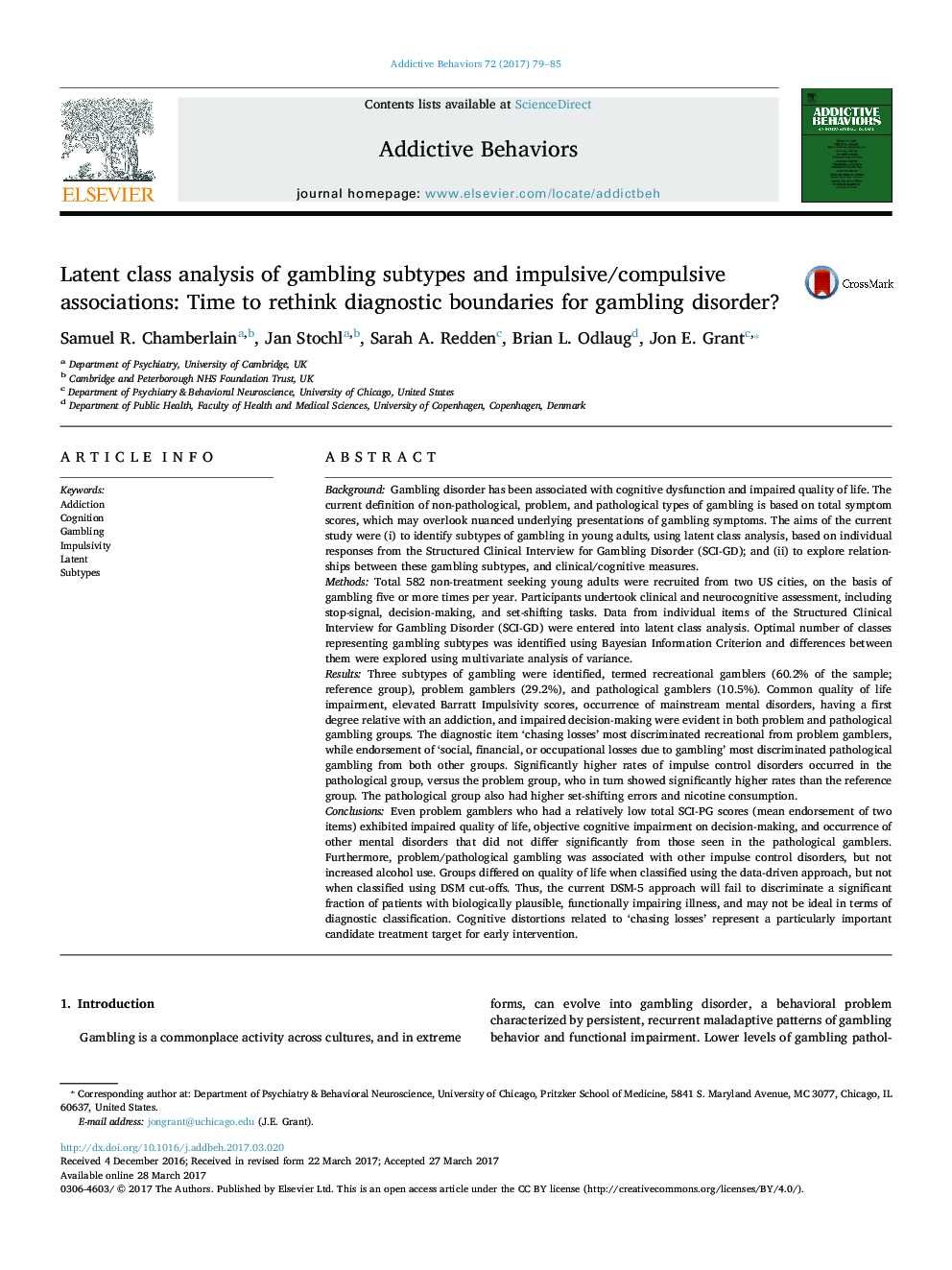| کد مقاله | کد نشریه | سال انتشار | مقاله انگلیسی | نسخه تمام متن |
|---|---|---|---|---|
| 5037767 | 1472499 | 2017 | 7 صفحه PDF | دانلود رایگان |
- Current classification of gambling pathology relies on total number of criteria met for gambling disorder (DSM-5)
- This approach can be seen as somewhat arbitrary and may overlook meaningful gambling subtypes
- Latent class analysis (LCA) was used to identify candidate subtypes of gambling in 582 gamblers.
- Compared to the reference class, both problem gamblers and gambling disorder classes showed relatively impaired quality of life, and more psychiatric morbidity.
- Both problem gamblers and gambling disorder classes also showed higher impulsivity scores and impaired decision-making.
- LCA classification was sensitive to group quality of life differences, whereas DSM-5 classification was not.
BackgroundGambling disorder has been associated with cognitive dysfunction and impaired quality of life. The current definition of non-pathological, problem, and pathological types of gambling is based on total symptom scores, which may overlook nuanced underlying presentations of gambling symptoms. The aims of the current study were (i) to identify subtypes of gambling in young adults, using latent class analysis, based on individual responses from the Structured Clinical Interview for Gambling Disorder (SCI-GD); and (ii) to explore relationships between these gambling subtypes, and clinical/cognitive measures.MethodsTotal 582 non-treatment seeking young adults were recruited from two US cities, on the basis of gambling five or more times per year. Participants undertook clinical and neurocognitive assessment, including stop-signal, decision-making, and set-shifting tasks. Data from individual items of the Structured Clinical Interview for Gambling Disorder (SCI-GD) were entered into latent class analysis. Optimal number of classes representing gambling subtypes was identified using Bayesian Information Criterion and differences between them were explored using multivariate analysis of variance.ResultsThree subtypes of gambling were identified, termed recreational gamblers (60.2% of the sample; reference group), problem gamblers (29.2%), and pathological gamblers (10.5%). Common quality of life impairment, elevated Barratt Impulsivity scores, occurrence of mainstream mental disorders, having a first degree relative with an addiction, and impaired decision-making were evident in both problem and pathological gambling groups. The diagnostic item 'chasing losses' most discriminated recreational from problem gamblers, while endorsement of 'social, financial, or occupational losses due to gambling' most discriminated pathological gambling from both other groups. Significantly higher rates of impulse control disorders occurred in the pathological group, versus the problem group, who in turn showed significantly higher rates than the reference group. The pathological group also had higher set-shifting errors and nicotine consumption.ConclusionsEven problem gamblers who had a relatively low total SCI-PG scores (mean endorsement of two items) exhibited impaired quality of life, objective cognitive impairment on decision-making, and occurrence of other mental disorders that did not differ significantly from those seen in the pathological gamblers. Furthermore, problem/pathological gambling was associated with other impulse control disorders, but not increased alcohol use. Groups differed on quality of life when classified using the data-driven approach, but not when classified using DSM cut-offs. Thus, the current DSM-5 approach will fail to discriminate a significant fraction of patients with biologically plausible, functionally impairing illness, and may not be ideal in terms of diagnostic classification. Cognitive distortions related to 'chasing losses' represent a particularly important candidate treatment target for early intervention.
Journal: Addictive Behaviors - Volume 72, September 2017, Pages 79-85
